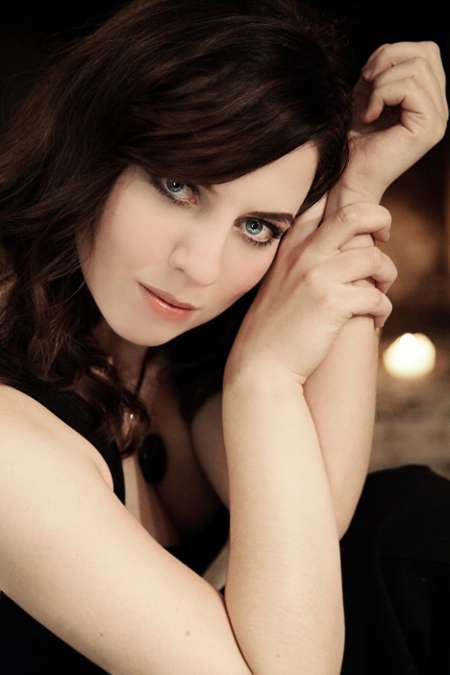|
Back
Allegro con Vivacity New York
Le Poisson Rouge
07/30/2012 -
Astor Piazzolla: Le Grand Tango (arranged for violin and piano)
Fred Hersch: Variations on a Theme of Tchaikovsky (New York Premiere)
Peter Ilych Tchaikovsky: Eugen Onegin: “Letter-Writing Scene” (arranged for violin and piano by Leopold Auer)
Johannes Brahms: Piano Sonata Nr. 2 in F sharp Minor, opus 2: Scherzo
Sergei Prokofiev: Piano Sonata Nr. 7 in B flat Major, Opus 83: Andante caloroso
Frédéric Chopin: Berceuse in D flat Major, Opus 57
Mily Balakirev: Islamey
Serge Rachmaninov: Etude-tableau in C minor, Opus 33 Nr. 3
Natasha Paremski (Piano), Philippe Quint (Violin)

N. Paremski (© Andrea Joynt)
Will the real Natasha Paremski please sit down? Or stand up?
In the far from rarefied Poisson Rouge, this young Russian-American pianist sliced through the audience like a two-bladed Japanese sushi knife. She insouciantly stood and chatted with an audience as young as she was, joked, told prurient stories, thanked her page-turner (definitely a first!) and was the perfect figure of a lively, ebullient and terrifically nice person.
When she sat down, Ms. Paremski’s other blade was so sharp that–like a maestro sushi maker–we couldn’t even see it at work. Her recital, lasting a little over one hour, had eight works which were explosive, glittering, rare and transformed her personal vivacity into an art form.
Part of that unofficial cabal of artists thriving equally on life and music, Ms. Paremski has worked with major orchestras, given major recitals, and, with her first recording, programs music quite uncommon.
Specifically, her program had well known composers with music that was way off the beaten track.
Astor Piazzolla is (happily) not a rare artists in New York, but few have heard Le Grand Tango written for Mstislav Rostropovich–who had never heard of the composer. When accidentally picked up the score from his drawer, he discovered it, was thrilled with the piece.
That cello original was fascinating and pure tango, the piano creating a dominant Argentine setting. Arranged for violin and piano here, Philippe Quint was the alpha partner, and the beginning disguised the tango tempo so that one was in no-man’s land. It is a fairly lengthy work, but Piazzolla was so interesting that when Ms. Paremski came to the fore with the original dance, the mysterious sounds were revealed as, yes, pure tango, which both performers played with great exuberance.
Another rarity, in fact a New York premiere, was jazz pianist Fred Kersch’s Tchaikovsky variations, specifically the opening of the Fourth Symphony slow movement. It was (to use Willard Romney’s word) a disconcerting experience.
No jazz (except for a Scott Joplin variation), nothing atonal or untoward, these could have been written by Johannes Brahms. They were very difficult, though Ms. Paremski more or less sailed through them. The consistent 16th notes, the left-over-right hand alternations, the counterpoint were made for a master pianist, but the voice was pure late 19th Century (albeit a few touches of Mendelssohn and Chopin) Tough for the artist, a snap for any audience.
Ms. Paremski apologized (jovially) for not making the recital pure Russian, and she did play an eloquent Chopin (the Berceuse) and an almost never-performed movement from Brahms’ early Second Sonata.
The rest came from her country of birth, and the choices, while excerpts, were hardly conformist. Instead of the crazy finale of Prokofiev’s Seventh, she played the far deeper slow movement. (That and a Rachmaninov the only introspective work on the program). The Tchaikovsky was Leopold Auer’s “letter-writing” scene from Eugen Onegin, with violinist Quint. A gooey work without singer, perhaps, but Ms. Paremski animated it with an introduction of how she sings it in the shower! (This is Poisson Rouge, not Carnegie Hall!)
I have a feeling she was playing to the appreciative crowd in the Balakirev Islamey. Those opening triplet 16th notes can theoretically never be played too quickly, but Ms. Paremski still whizzed through them not like a pianist but like the wind. The middle section–which is oh so Russian–was offered with all the richness, sensuousness and gaudy ersatz “Oriental” flavor which it deserved.
True enough, this was a very special venue with an uncommon audience. But Ms. Paremski demonstrated that Russian soul and American exuberance can be a powerful combination.
Harry Rolnick
|